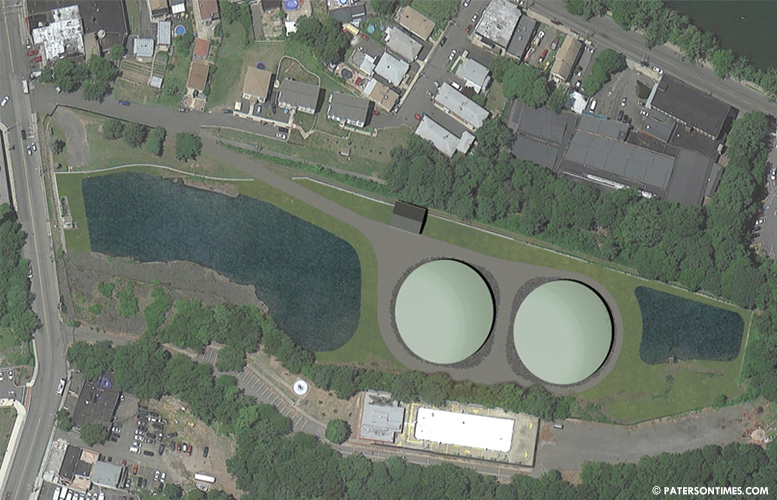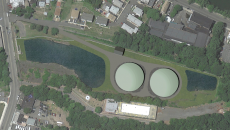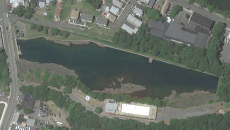Plan to drain Levine Reservoir come under public criticism
By Jayed Rahman
Published: February 27, 2014

The Passaic Valley Water Commission’s plan to drain the Stanley M. Levine Reservoir and place two large concrete water storage container on the site came under criticism during a Historic Preservation Commission meeting on Monday.
“These tanks are just wrong. Just doesn’t look right,” said David Soo, head of the Friend of the Great Falls. “Just wrong to do it here.”
The water commission intends to place two large concrete containers, each 21 feet high from the ground with capacity to store 2.5 million gallons of water, in the current Levine Reservoir site after draining it, according to Jerry Notte, project manager with CH2M Hill, a Colorado based design firm hired by the water commission.
What has irked residents like Soo is that the reservoir, where the water commission plans to place the large containers, is located within the Historic Great Falls District.
The “round storage tanks” planned for the site will be visible from miles away. “We’re going to put in a bunch of trees and cover up,” said Notte, to alleviate aesthetic concerns.
The New Jersey Historic Preservation Office agrees with Soo. “The SHPO anticipated that the proposed project would have an adverse effect upon historic properties,” that according to Marianne Walsh, a historic preservation specialist, who is advising the city’s preservation commission.
“Once you treat the water, you don’t put it out into the pond,” said Joseph Bella, head of the water commission. Bella went through a presentation during the meeting explaining steps taken to purify drinking water. He said presently, after the water is treated it is pumped back into the reservoir, where there is a potential for harmful pathogens to mix with the treated water.
Bella said the water commission is implementing the Environmental Protection Agency’s ruling (Safe Drinking Water Act ) that treated water has to be covered so as to avoid the encroachment of harmful viruses and bacteria like Cryptosporidium and E. coli. In open reservoirs, like the Levine, said Bella, pathogens “go wild” when the treated water is held in an open reservoir.
“We looked at some offsite elevated storage tanks,” said Notte. “There was really no suitable land available.”
Notte stated that the water commission found one parcel of land that would be suitable for the project, but the owner was unwilling to sell. Jose Torres, the former mayor of the city, said if there is land the city can use its eminent domain power to obtain it.
Kenneth Simpson, preservation commission board member, asked whether it would be practical for the water commission to simply leave the reservoir alone. If the reservoir is left alone, said Notte, it would be abandoned. “There’s no river system that supplies it like other ponds, so if you really pull that out of the system, you’ll have to really engineer a solution,” said Notte. “The Levine Reservoir would really be abandoned.”
“Would you may be able to use the other reservoir to do the same job as this reservoir?” asked Gianfranco Archimede, director of the preservation commission. Archimede wanted to know whether the water commission, which has three reservoirs with Levine being the smallest, could transfer the burden of the Levine to the nearby New Street reservoir in Woodland Park, leaving the city’s historic site untouched.
“One of the most serious concerns we have with that is it would take all those water mains, some of which are hundred plus years old, and more than double the operating pressure on those mains,” answered Paul Paparella, water commission’s consultant. Paparella said about 20 miles of pipelines would be impacted if the switch was made. “We have no way of assessing whether or not those mains could take that increased pressure without experiencing a lot of problem,” said Paparella.
Georgette Deroche, a city resident, who opposes the project, asked, “Why was the public input of such little interest to our Passaic Valley Water Commission?”
The public were not informed of the alternatives available, said Bob Guarasci, who runs the charter school on Spruce Street within the historic district. “It’s disingenuous for the Passaic Valley Water Commission to pretend it wants public input when it missed this opportunity during the most crucial part of the project: the alternative analysis.”
Guarasci, who described the containers as “concrete monstrosities,” said, “A full set of alternatives were never explored.” Officials said alternatives were weighed. Some were expensive while others were impractical. The water commission considered installing floating cover, but said Notte, “A lot of floating cover collapse.” And they are expensive to maintain.
The $120 million project to implement EPA regulation will likely be completed by 2017. “Construction will run through first half of 2017,” said Notte. The city’s reservoir is phase one out of three phases that are set to implement the EPA regulation – each phases addresses each of the three reservoirs in the water commission’s system.
“The design needs to be completed by July 2014,” said Notte. “We’re almost 60% complete with the design phase.” After the design completion permits will be obtained within six months to start construction at the site.
In 2013 the water commission attempted to place large containers in the New Street and Great Notch Reservoirs, both located in Woodland Park, but mobilized local officials managed to drive out the water commission from that town by employing letter writing campaign and legal threats.
Some have urged the water commission to wait until the EPA reviews the regulations in 2016. “There’s no indication from EPA that this is going to change,” said Karen Fell of the New Jersey Department of Environmental Protection.
Since the district is part of the National Register of Historic Places it must go through a process called Section 106 Review. The lengthy federal review checks to ensure historic places and properties are not molested by development. According to Soo the review sometimes takes a decade or more, and by that point this project may be abandoned by the water commission.
“This not something that is going to be in keeping with the historic character of the district,” said Soo. “Just doesn’t feel right.”

